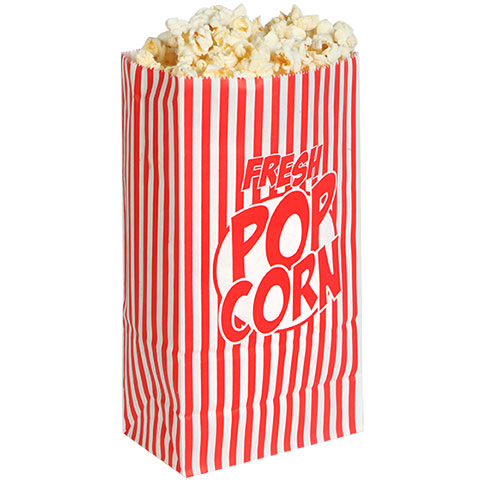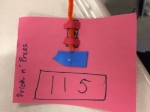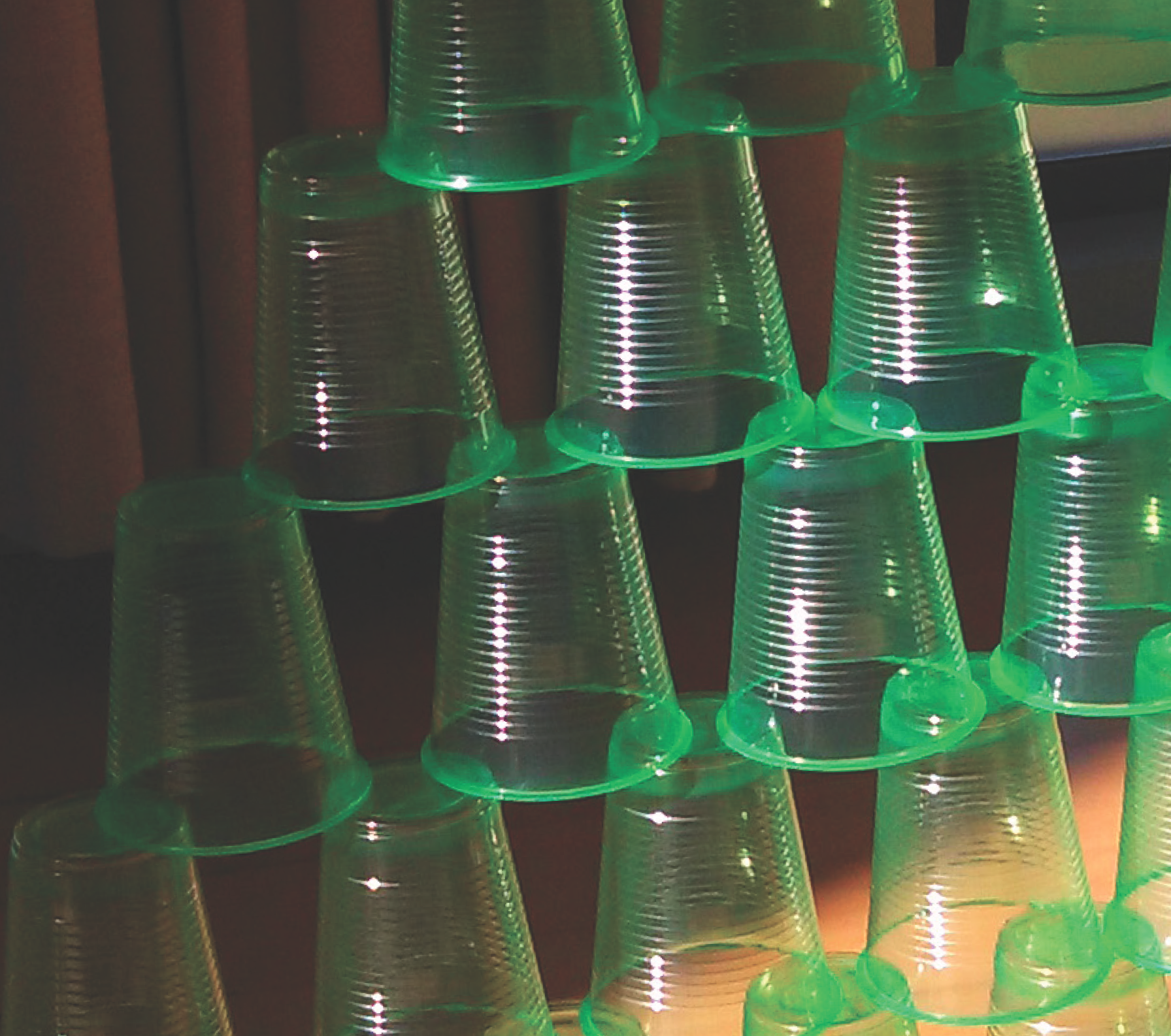Get creative and design #functionalfashion with free CAD programs
Leaf Chromatography
ESTIMATED COST:
$0.14
PER STUDENT
Required materials:
several leaves from different trees, small glass containers, rubbing alcohol, paper coffee filters, shallow aluminum pan, hot tap water, aluminum foil, scissors, tape, marker, sticky notes, plastic spoons
TED-Ed Description:
It's true that the cooler weather is a good indication that the seasons are changing, but there's no sign like the color of the leaves. In this lesson, you'll learn why leaves change color in the fall, and you'll learn how to do paper chromatography to separate the pigments found in a leaf.
NGSS alignment:
1. Asking questions (for science) and defining problems (for engineering) 3. Planning and carrying out investigations 6. Constructing explanations (for science) and designing solutions (for engineering) 7. Engaging in argument from evidence 8. Obtaining, evaluating, and communicating information
Tech in a Bag
Required materials:
household or classroom items, i.e. plastic snack bags, sticky notes, toothpaste, pair of scissors, markers, pencils, etc. within a paper lunch bag
Description:
Many students believe that technology only refers to things powered by electricity. In this lesson, each group of students gets a “mystery bag” containing an example of technology. When students open their bags, they may be surprised to see that they contain everyday objects like sponges, slippers, or bubblegum! (eie.org)
Tips:
Nothing necessarily needs to be bought for this lesson except possibly the paper bags. Many household or classroom items that you already have will work for this activity and can be reused multiple times. Items listed here have already been tested with students as a part of this lesson. My favorite items to use come from the kitchen: Cyclone by Quirky, a spork, gloves, recipe cards, etc.
1. Asking questions (for science) and defining problems (for engineering) 6. Constructing explanations (for science) and designing solutions (for engineering) 7. Engaging in argument from evidence 8. Obtaining, evaluating, and communicating information
Adaptive Design Challenge
Suggested materials:
craft materials, i.e. masking (or scotch tape), string, chenille stems (pipe cleaners), markers, toothpicks, fastener strip (Velcro), construction paper
Description:
According to TryEngineering.org, engineers have developed products that help those with physical challenges lead more comfortable and independent lives. As shown in the videos below, adaptive designs not only help those in need, adaptive designs help everyone and make life better for all!
Tips:
Many craft, household or classroom items that you already have will work for this activity and can possibly be reused. Items listed here have already been tested with students as a part of this lesson. Students should be given access to as many or as few materials as you can afford. Allow students to be creative. I've done this activity with only toothpicks, markers and construction paper!
1. Asking questions (for science) and defining problems (for engineering) 2. Developing and using models 6. Constructing explanations (for science) and designing solutions (for engineering) 8. Obtaining, evaluating, and communicating information
Study Extreme Weather with a Dollar Store Barometer
ESTIMATED COST:
$0.07
PER STUDENT
Required materials:
jar or can, large balloon, rubber band, scissors, tape, stirring stick or straw, index card
Description:
A barometer is an instrument that measures air pressure, allowing weather forecasters and scientists to better predict extreme weather events. Actually, you don’t need to be a professional weather reporter to understand weather patterns. This easy to assemble barometer made from dollar store items can help!
Tips:
Craft, household or classroom items that you already have will work for this activity and can possibly be reused.
NGSS alignment:
2. Developing and using models 3. Planning and carrying out investigations 4. Analyzing and interpreting data 5. Using mathematics and computational thinking 6. Constructing explanations (for science) and designing solutions (for engineering) 8. Obtaining, evaluating, and communicating information
Paper Airplanes: Real-Life Algorithms
ESTIMATED COST:
$0.08
PER STUDENT
Required materials:
paper, scissors, glue
Code.org Description:
This lesson calls out ways we use algorithms in our daily lives, specifically making paper airplanes. This lesson also focuses on the bigger picture of computer science and how algorithms play an essential part.
NGSS alignment:
2. Developing and using models 4. Analyzing and interpreting data 5. Using mathematics and computational thinking 8. Obtaining, evaluating, and communicating information
Conditionals with Cards
ESTIMATED COST:
$0.12
PER STUDENT
Required materials:
paper, markers, glue
Hour of Code Description:
We don’t always know ahead of time what things will be like when we run our computer programs. Different users have different needs, and sometimes you will want to do something based off of one user’s need that you don’t want to do with someone else. That is where conditionals come in. This lesson demonstrates how conditionals can be used to tailor a program to specific information.
NGSS alignment:
2. Developing and using models 4. Analyzing and interpreting data 5. Using mathematics and computational thinking 8. Obtaining, evaluating, and communicating information
Graph Paper Programming
ESTIMATED COST:
$0.08
PER STUDENT
Required materials:
paper, markers, glue
Code.org Description:
This lesson calls out ways we use algorithms in our daily lives, specifically making paper airplanes. This lesson also focuses on the bigger picture of computer science and how algorithms play an essential part.
NGSS alignment:
2. Developing and using models 4. Analyzing and interpreting data 5. Using mathematics and computational thinking 8. Obtaining, evaluating, and communicating information
Muscle Models
ESTIMATED COST:
$0.07
PER STUDENT
Required materials:
rubber bands, craft sticks, straws, metal brads, ruler, metal paper clip
Description:
Humans have 600+ muscles but only a set number of muscle fiber at birth. These fibers can increase in strength and size with exercise. In these lessons, students can learn the cellular mechanisms that lead to muscle growth as well as create and test models of muscle fiberss.
NGSS alignment:
1. Asking questions (for science) and defining problems (for engineering) 2. Developing and using models 3. Planning and carrying out investigations 4. Analyzing and interpreting data 5. Using mathematics and computational thinking 6. Constructing explanations (for science) and designing solutions (for engineering) 7. Engaging in argument from evidence 8. Obtaining, evaluating, and communicating information
Electrifying STEM: Circuits and Batteries
ESTIMATED COST:
$0.07
PER STUDENT
Required materials:
"switches," wire strippers, insulated wire, flashlight, lightbulbs, batteries, electrical tape
Description:
TED-Ed calls batteries a "triumph of science." They allow electronics to operate "without anchoring us to an infernal tangle of power cables." The activities above take learners from simple circuits to an electrifying design challenge.
Tips:
Scissors may be used instead of wire strippers, but may take extra practice to strip the wire. Select a flashlight that can be easily disassembled so that the lightbulb can be removed. Also, replacing flashlights with lightbulbs may be more cost effective.
NGSS alignment:
1. Asking questions (for science) and defining problems (for engineering) 2. Developing and using models 6. Constructing explanations (for science) and designing solutions (for engineering) 8. Obtaining, evaluating, and communicating information
Keep Calm and Just Breathe
ESTIMATED COST:
$0.12
PER STUDENT
Required materials:
plastic soft drink bottle, straw, rubber band, scissors, balloons, clay
Description:
Breathing ensures oxygen is transported to cells so they can function while removing carbon dioxide, a byproduct of this process. This lesson involves constructing a model lung to show how the complex process of breathing keeps us all alive.
Tips:
Materials don't necessarily have to be purchased new for this activity. Household or classroom items that you already have can be used and reused for this activity, saving you even more money!
NGSS alignment:
2. Developing and using models 6. Constructing explanations (for science) and designing solutions (for engineering) 8. Obtaining, evaluating, and communicating information
STEM in the Sun Lesson: Here Comes the Sun
ESTIMATED COST:
$0.15
PER STUDENT
Required materials:
used or new basic calculator, eyeglass repair kit or mini screwdriver, scotch tape
Description:
The Here Comes the Sun activity explores the concept of how solar energy is gathered by solar panels and adapted to provide power to a variety of machines, from calculators to spacecraft. Students disassemble a solar powered calculator to explore the component parts and work in teams to suggest design enhancements to the calculator to improve performance.
1. Asking questions (for science) and defining problems (for engineering) 2. Developing and using models 6. Constructing explanations (for science) and designing solutions (for engineering) 8. Obtaining, evaluating, and communicating information
Pixel Perfect Low-tech Comp Sci
ESTIMATED COST:
$0.08
PER STUDENT
Required materials:
markers and graph paper (or index cards and a ruler)
Description:
This low-tech offline lesson plan covers the basics of computer graphics. After learning about how graphics work, students will create their own Color by Pixel programs.
Tips:
If graph paper is difficult to find, create the grids on index cards with a ruler. For a high-tech extension of this lesson, click here.
NGSS alignment:
2. Developing and using models 3. Planning and carrying out investigations 4. Analyzing and interpreting data 5. Using mathematics and computational thinking 8. Obtaining, evaluating, and communicating information
Low-tech Comp Sci: Robot Friends
Required materials:
paper, markers, cups
Description:
This computer science lesson is a great low-tech introduction to coding. My Robotic Friends teaches students the connection between symbols and actions, as well as the valuable skill of debugging. Using a predefined “Robot Vocabulary,” students will figure out how to guide one another to accomplish specific tasks without discussing them first.
Tips:
The lesson plan has great adjustments for lower elementary, upper elementary and grades 7+.
NGSS alignment:
2. Developing and using models 4. Analyzing and interpreting data 5. Using mathematics and computational thinking 8. Obtaining, evaluating, and communicating information
Folding for Outer Space
Recommended materials:
aluminum foil, tape, small cardboard boxes
Description:
In this lesson, participants will explore how scientists and engineers incorporate folding and unfolding into many fascinating applications and technologies like telescopes and solar panels to study our galaxy and beyond.
Tips:
Many craft, household or classroom items that you already have will work for this activity and can possibly be reused. The recommended materials listed above have already been tested as a part of this lesson. Students should be given access to as many or as few materials as you can afford. Allow students to be creative. I've done this activity with only foil, tape and one small reused gift box! After finishing the activity, reuse the gift boxes to get the most "folds" for your money!
NGSS alignment:
1. Asking questions (for science) and defining problems (for engineering) 6. Constructing explanations (for science) and designing solutions (for engineering) 7. Engaging in argument from evidence 8. Obtaining, evaluating, and communicating informatio
BubbleSci
ESTIMATED COST:
$0.27
PER STUDENT
Recommended materials:
different types of soap (dish soap, hand soap, bubble bath, etc.), glycerin or corn syrup, items to make bubble wands (pipe cleaners, straws, etc.), measuring tools (cups, spoons, droppers, etc.), stopwatch (or smartphone app), distilled water, containers like cups or empty bubble solution bottles for students to test and keep their solutions.
Description:
Blowing bubbles may seem like a simple or childish pastime. However, blowing a bubble is packed with STEM concepts from physics to geometry to art (with that STEM becomes STEAM!). The lessons provided above allow teachers to take this activity in many directions to suit their instructional needs. For an engineering route, set up design challenges for the bubble wand and the solution. For a math route, study shapes, ratios or volume calculations. For a physics or chemistry route, experiment with air speed, solutions, surface tension and more.
Tips:
If glycerin is difficult to find, corn syrup can be used instead. Also, your local dollar store may carry small bubble containers with wands as party or wedding favors, which make great containers to store students' final solutions.
NGSS alignment:
1. Asking questions (for science) and defining problems (for engineering) 2. Developing and using models 3. Planning and carrying out investigations 4. Analyzing and interpreting data 5. Using mathematics and computational thinking 6. Constructing explanations (for science) and designing solutions (for engineering) 7. Engaging in argument from evidence 8. Obtaining, evaluating, and communicating information
2 Lessons, 1 Tiny Concept: Intro to Nano
ESTIMATED COST PER STUDENT:
Lesson 1 = $0.10
Lesson 2 = $0.04
Required materials:
Lesson 1: scissors, pencil, crayon, eraser, pencil sharpener, index card, chalk, calculator, a doorknob (within classroom), roll of tape
Lesson 2: clear cups, antacid tablets, water
Description:
Lesson 1 focuses on how to measure at the nano scale and provides students with an understanding of how small a nanometer really is. Students learn about electron microscopes, participate in hands-on activities to measure common classroom objects in the metric scale, and then convert the result to nanometers.
Lesson 2 focuses on how materials behave differently as their surface area increases. Students will learn about nanotechnology and how engineers can harness the differences in how materials behave when small to solutions for challenges in many industries.
Tips:
Many craft, household or classroom items that you already have will work for this activity and can be reused multiple times. One class can use one of each item if students can exchange or trade them between groups as they work through their data collection from measuring the length (or diameter for the tape).
NGSS alignment:
1. Asking questions (for science) and defining problems (for engineering) 2. Developing and using models 3. Planning and carrying out investigations 4. Analyzing and interpreting data 5. Using mathematics and computational thinking 6. Constructing explanations (for science) and designing solutions (for engineering) 7. Engaging in argument from evidence 8. Obtaining, evaluating, and communicating information
Functional Fashion Challenge
ESTIMATED COST:
$0
PER STUDENT*
Required materials:
Any free CAD software i.e. Autodesk Inventor (free student version) or Morphi*
Description:
Design challenges provide opportunities to apply skills and knowledge in unique and creative ways. Designers are often asked to create or innovate products that solve complex problems, yet address aesthetic requirements to make the product as profitable as possible. As you will discover with this challenge, designers sometimes have to embody the role of engineers and artists to ensure all solutions also are aesthetically pleasing and creative enough to serve multiple purposes.
Tips*:
No materials are needed for this project except the teacher's choice of CAD software and one compatible computer per 1-2 students. Basic craft materials can be used to prototype students' physical designs or elevate the activity by 3D printing the prototypes.
1. Asking questions (for science) and defining problems (for engineering) 2. Developing and using models 6. Constructing explanations (for science) and designing solutions (for engineering) 8. Obtaining, evaluating, and communicating information
Sink, Float, Hover Challenge
ESTIMATED COST:
$0.05
PER STUDENT
Required materials:
small containers with lids (film canisters work best), variety of small, heavy objects (coins, washers, marbles, etc.), variety of small, lightweight objects (corks, beads, Styrofoam, etc.), rubber bands (optional to keep lid on canisters or modify distribution of mass), and large containers of water
Description:
Students will learn about density, buoyancy, and how submarines dive. Students will design and create a vessel that is able to sink, hover, and float.
Tips:
Many craft, household or classroom items that you already have will work for this activity and can possibly be reused. Items listed here have already been tested with students as a part of this lesson. Students should be given access to as many or as few materials as you can afford. This allows students to be more creative.
1. Asking questions (for science) and defining problems (for engineering) 2. Developing and using models 3. Planning and carrying out investigations 4. Analyzing and interpreting data 6. Constructing explanations (for science) and designing solutions (for engineering) 8. Obtaining, evaluating, and communicating information
Pepsi v. Coke (or Aquafina v. Dasani) Experiment
Required materials:
paper drinking cups, Pepsi and Coke (or Aquafina and Dasani)
Description:
Does gender actually affect your ability to taste? Can girls taste the difference between Pepsi and Coke better than boys? These may seem like silly questions, but they can be used to provide an introduction to designing scientific experiments. In this lesson, students will learn what experimental design is, as well as design and complete their own scientific experiment.
3. Planning and carrying out investigations 4. Analyzing and interpreting data 5. Using mathematics and computational thinking





















